Civil justice statistics in Scotland: 2013-2014
The 2013-14 Civil Justice in Scotland release includes:
1. Main statistics tables (compromising tables that appear in this bulletin)
2. Divorce & dissolution statistics tables (further breakdowns on divorce & dissolution)
3. Supplementary statistics tables (additional statistics on civil law cases in sheriff courts and the Court of Session)
4. Background data tables (an interactive dataset on civil law court cases by court, that can be used to generate user customised tables and charts)
This document is part of a collection
4. General trends
There were 77,173 civil law cases initiated in 2013-14, a similar number to 2012-13
Sheriff courts accounted for 94 per cent of civil law cases and 41 per cent of cases in sheriff court were small claims
Survey data shows civil law problems were experienced by nearly a quarter of the adult population
Most civil legal aid grants are made for family cases
Scottish Crime and Justice Survey: civil justice module
The Scottish Crime and Justice Survey (SCJS)[1] includes questions on experience of and response to civil law problems. Respondents were asked about civil problems which may raise a legal issue or which, if not resolved earlier, could ultimately result in legal proceedings, for example, welfare rights, debt, housing, employment, divorce or separation and consumer issues. Respondents were asked if, over the previous three years prior to interview[2], they had experienced any of a list[3] of named problems or disputes. They were then asked whether they attempted to solve them, if they used help or advice in that process and if so from whom.
The problem areas covered were:
- home or family living arrangements
- money, finances or anything paid for
- unfair treatment
- health and well-being
The 2012-13 SCJS shows that almost one in four (23 per cent) adults had experienced at least one of the civil law problems asked about in the last three years.
Within the areas listed above, 14 per cent of adults had experienced problems with home or family living arrangements, eight per cent had experienced problems with money, finances or anything they had paid for, five per cent had been treated unfairly in some respect and four per cent had experienced health or well-being problems.
The most common single problem was with neighbours, experienced by nine per cent. The next most common civil law problems involved faulty goods or services (three per cent) and money & debt (three per cent) (Figure 4).
Figure 4: Experience of civil law problems: SCJS 2012-13
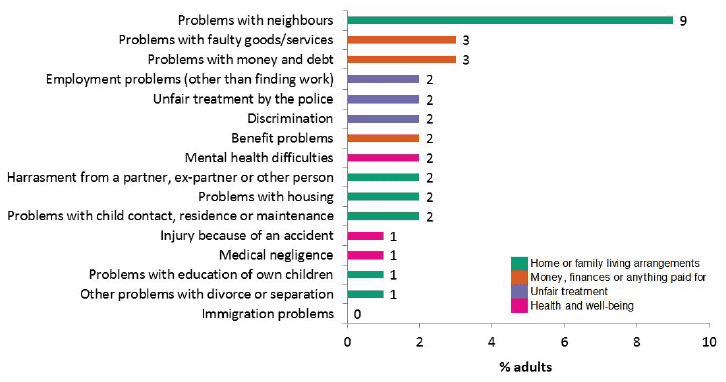
A third of all respondents with one or more civil law problem in the last three years said a problem concerning neighbours was the most important or only problem to solve, while 10 per cent of problems involved faulty goods or services.
Of those who identified the most important or only problem, 31 per cent reported the problem began less than 12 months ago, 20 per cent reported the problem began over a year but less than two years ago and 30 per cent reported the problem began over three years ago. Nineteen per cent of respondents who did not know when the issue started.
Those who had experienced a problem were also asked about the current situation of their most important problem. Less than half (46 per cent) had resolved the problem whilst just over a third (34 per cent) were still trying to resolve the problem. Around one in ten had tried to resolve the problem but had to give up (9 per cent) or were not planning to do anything (8 per cent). Of those not planning to do anything, 42 per cent felt it was not worth the effort and 28 per cent didn't think anything could be done.
For those who had resolved their problem, 24 per cent said it had taken less than a month, while 26 per cent had taken between one and six months.
Where respondents had identified the most important or only problem, 18 per cent planned to contact either a Citizens Advice Bureau (or similar advice organisation) and 17 per cent a solicitor or lawyer. Of those who had not either contacted or planned to contact a Citizens Advice Bureau (or similar advice organisation), around a third (34 per cent) felt able to deal with the problem without their help and just over a quarter (28 per cent) didn't think they could do anything to help. Fourteen per cent didn't know these organisations dealt with the sort of problem they had experienced.
Those who had not either contacted or planned to contact a solicitor or lawyer gave similar responses: 30 per cent felt able to deal with the problem without their help and 19 per cent didn't think they could do anything to help. In addition, 17 per cent didn't think the problem was serious enough to involve a solicitor or lawyer and 16 per cent were worried about the cost or didn't want to pay the cost.
Of all respondents who identified the most important or only problem, 34 per cent sought information, advice or help from sources other than friends or family, Citizens Advice Bureau (or similar advice organisation), or solicitor or lawyer. These sources of help are shown in Figure 5.
Figure 5: Other sources of help or advice, SCJS 2012-13
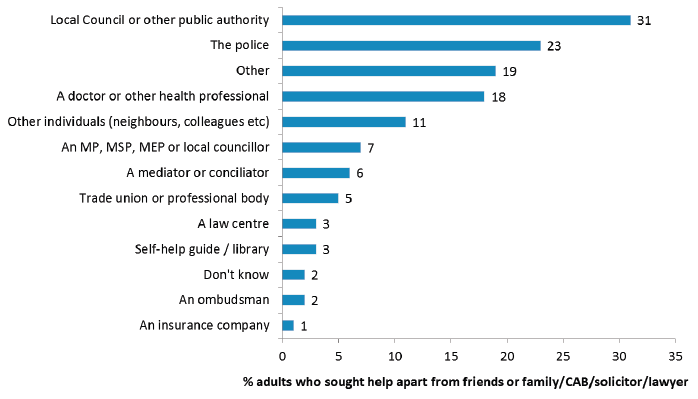
Respondents who sought help from a Citizens Advice Bureau (or similar organisation) received advice (68 per cent), information (51 per cent) or had the organisation contact the other party on their behalf (16 per cent). Those who sought help from a solicitor or lawyer received advice (48 per cent), had them contact the other party on their behalf (39 per cent) or received information (29 per cent) whilst over a quarter (28 per cent) received representation in court or in a tribunal.
Vulnerable groups are more likely to experience civil law problems than the general population. Those who live in areas of multiple deprivation suffered a higher prevalence of civil justice problems (32 per cent), as did victims of crime (35 per cent) compared to 23 per cent overall in 2012-13. Those who live in rented (as opposed to owner occupied) accommodation are also more likely to experience civil law problems: 32 per cent for social rent and 30 per cent for private rent as opposed to 18 per cent for owner occupied.
Courts
There were 77,173 civil law cases initiated across the Court of Session and sheriff courts in 2013-14 (not including summary applications). This was similar to the number of cases initiated the previous year halting the downward trend over the previous years. The number of cases initiated was 41 per cent lower than 2008-09 when this series of statistics began (Figure 6 and Table 1).
Figure 6: Civil law cases initiated across Court of Session and sheriff courts
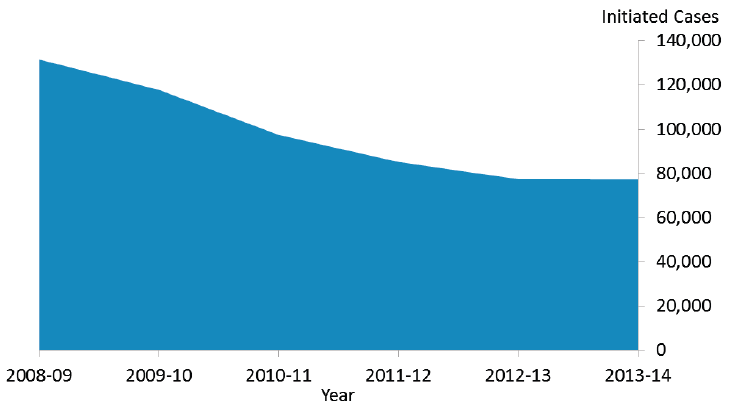
There were 70,267 disposals of civil law cases in 2013-14. This was a small drop of four per cent compared to 2012-13 but 39 per cent lower than 2008-09, so the trend in disposals is similar to initiations.
The decrease in civil law cases has been fairly consistent across sheriffdoms, procedures and case types, but there are some exceptions. The decrease in the number of cases initiated in the Court of Session is much smaller than for sheriff courts. The number of family cases initiated has also decreased less than most other types of cases. Personal injury cases have seen an overall increase since 2008-9 but have decreased by 15 per cent from a peak in 2009-10.
Table 1: Civil law cases initiated and disposed in the Court of Session and sheriff courts, 2008-09 to 2013-14
| Cases | 2008-09 | 2009-10 | 2010-11 | 2011-12 | 2012-13 | 2013-14 | % change on 2012-13 |
% change on 2008-09 |
|
|---|---|---|---|---|---|---|---|---|---|
| Initiated | Court of Session | 5,329 | 6,152 | 5,176 | 4,754 | 4,943 | 4,662 | -6 | -13 |
| Sheriff courts | 126,304 | 111,737 | 92,308 | 80,502 | 72,510 | 72,511 | 0 | -43 | |
| All courts | 131,633 | 117,889 | 97,484 | 85,256 | 77,453 | 77,173 | 0 | -41 | |
| Disposed | Court of Session | 4,022 | 4,356 | 4,295 | 4,856 | 4,712 | 4,911 | 4 | 22 |
| Sheriff courts | 111,541 | 104,831 | 87,504 | 77,147 | 68,781 | 65,356 | -5 | -41 | |
| All courts | 115,563 | 109,187 | 91,799 | 82,003 | 73,493 | 70,267 | -4 | -39 | |
1. Figures for initiations and disposals do not necessarily refer to the same cases.
2. Excludes appeals and reclaiming motions in the inner house.
3. Excludes summary applications.
4. Court of Session and All Courts statistics for 2013-14 corrected November 2015.
There were 4,662 cases initiated across the General Department, Petition Department and Inner House of the Court of Session and a similar number disposed. Nearly three quarters (72 per cent) of cases in the Court of Session are dealt with in the General Department (but note that the number of cases shown for the Inner House excludes appeals and reclaiming motions) (Table 2).
Table 2: Cases initiated and disposed in the Court of Session, 2008-09 to 2013-14
| Court of Session department | Cases | 2008-09 | 2009-10 | 2010-11 | 2011-12 | 2012-13 | 2013-14 | % change on 2012-13 |
|---|---|---|---|---|---|---|---|---|
| General Department | Initiated | 3,736 | 4,479 | 3,723 | 3,390 | 3,568 | 3,359 | -6 |
| Disposed | 2,961 | 3,167 | 3,187 | 3,455 | 3,405 | 3,656 | 7 | |
| Petition Department | Initiated | 1,473 | 1,555 | 1,358 | 1,223 | 1,211 | 1,179 | -3 |
| Disposed | 988 | 1,094 | 1,035 | 1,299 | 1,191 | 1,126 | -5 | |
| Inner House2 | Initiated | 120 | 118 | 95 | 141 | 164 | 124 | -24 |
| Disposed | 73 | 95 | 73 | 102 | 116 | 129 | 11 | |
| Total | Initiated | 5,329 | 6,152 | 5,176 | 4,754 | 4,943 | 4,662 | -6 |
| Disposed | 4,022 | 4,356 | 4,295 | 4,856 | 4,712 | 4,911 | 4 |
1. Figures for initiations and disposals do not necessarily refer to the same cases.
2. First instance business only - excludes appeals and reclaiming motions.
3. Statistics for 2013-14 corrected November 2015.
In 2013-14 there were 72,511 civil law cases initiated and 65,356 cases disposed in the sheriff courts. While the number of cases initiated and disposed was similar to the previous year these have fallen by 43 and 41 per cent respectively since 2008-09. Cases initiated using the small claim procedure have decreased the least since 2008-09 and now make up 41 per cent of cases initiated in the sheriff courts (Figure 7 and Table 3).
All sheriffdoms in Scotland have seen an overall drop in the number of cases initiated and disposed since 2008-09. However, between 2012-13 and 2013-14 there were small rises in cases initiated in Lothian and Borders, North Strathclyde and Grampian, Highlands and Islands (Table 4).
Figure 7: Overview of the civil law cases in the sheriff courts and Court of Session reported in this bulletin, 2013-14
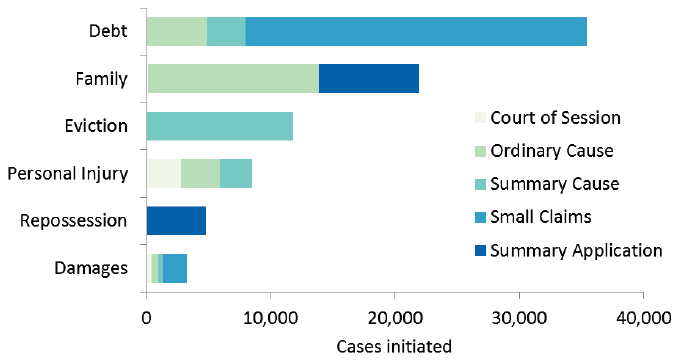
Table 3: Cases initiated and disposed of in the sheriff courts, by procedure, 2008-09 to 2013-14
| Cases | Procedure | 2008-09 | 2009-10 | 2010-11 | 2011-12 | 2012-13 | 2013-14 | % change on 2012-13 |
|---|---|---|---|---|---|---|---|---|
| Initiated | Ordinary cause | 46,477 | 42,823 | 34,123 | 26,021 | 24,957 | 24,026 | -4 |
| Summary cause | 32,736 | 27,464 | 23,799 | 22,783 | 18,510 | 18,852 | 2 | |
| Small claim | 47,091 | 41,450 | 34,386 | 31,698 | 29,043 | 29,633 | 2 | |
| Total initiated | 126,304 | 111,737 | 92,308 | 80,502 | 72,510 | 72,511 | 0 | |
| Disposed | Ordinary cause | 38,902 | 33,911 | 29,768 | 23,410 | 20,733 | 19,575 | -6 |
| Summary cause | 31,231 | 27,568 | 24,036 | 22,434 | 19,831 | 17,876 | -10 | |
| Small claim | 41,408 | 43,352 | 33,700 | 31,303 | 28,217 | 27,905 | -1 | |
| Total disposed | 111,541 | 104,831 | 87,504 | 77,147 | 68,781 | 65,356 | -5 |
1. Excludes summary applications.
2. Figures for initiations and disposals do not necessarily refer to the same cases.
Table 4: Cases initiated and disposed of in the sheriff courts, by sheriffdom, 2008-09 to 2013-14
| Cases | Sheriffdom | 2008-09 | 2009-10 | 2010-11 | 2011-12 | 2012-13 | 2013-14 | % change on 2012-13 |
2013-14 cases per 1,000 population3 |
|---|---|---|---|---|---|---|---|---|---|
| Initiated | Tayside, Central and Fife | 22,456 | 20,204 | 16,816 | 14,759 | 14,006 | 13,590 | -3 | 13 |
| Glasgow and Strathkelvin | 24,919 | 22,389 | 17,784 | 16,305 | 14,313 | 13,433 | -6 | 19 | |
| South Strathclyde, Dumfries and Galloway | 22,949 | 19,457 | 16,869 | 14,171 | 12,968 | 12,870 | -1 | 14 | |
| Lothian and Borders | 24,469 | 21,439 | 16,211 | 14,148 | 11,554 | 11,755 | 2 | 12 | |
| North Strathclyde | 17,177 | 14,907 | 12,954 | 10,577 | 9,932 | 10,447 | 5 | 13 | |
| Grampian, Highlands and Islands | 14,334 | 13,341 | 11,674 | 10,542 | 9,737 | 10,416 | 7 | 12 | |
| Scotland total initiated | 126,304 | 111,737 | 92,308 | 80,502 | 72,510 | 72,511 | 0 | 14 | |
| Disposed | Tayside, Central and Fife | 20,160 | 18,730 | 16,081 | 14,343 | 13,268 | 12,476 | -6 | 12 |
| Glasgow and Strathkelvin | 21,315 | 20,059 | 16,134 | 15,630 | 13,544 | 11,828 | -13 | 16 | |
| South Strathclyde, Dumfries and Galloway | 20,829 | 18,759 | 15,979 | 13,749 | 12,466 | 11,801 | -6 | 13 | |
| Lothian and Borders | 20,384 | 20,948 | 15,957 | 13,494 | 11,595 | 11,029 | -5 | 11 | |
| North Strathclyde | 15,687 | 13,455 | 12,218 | 9,921 | 8,803 | 8,949 | 2 | 11 | |
| Grampian, Highlands and Islands | 13,166 | 12,880 | 11,135 | 10,010 | 9,105 | 9,273 | 2 | 10 | |
| Scotland total disposed | 111,541 | 104,831 | 87,504 | 77,147 | 68,781 | 65,356 | -5 | 12 |
1. Excludes summary applications.
2. Figures for initiations and disposals do not necessarily refer to the same cases.
3. Based on mid-2013 small area population estimates provided by National Records of Scotland.
The mid-2013 population estimates were used to create population estimates for each sheriffdom (Supplementary Table S13). These estimates were then used to calculate the number of cases initiated and disposed per 1,000 population. This allows the incidence of civil law cases in each sheriffdom to be directly compared. The overall number of cases initiated across Scotland is 14 for every 1,000 people. This rate is similar for all sheriffdoms with the exception of Glasgow and Strathkelvin where the incidence is higher at 19 cases initiated for every 1,000 people (Table 4). The reason for this is unclear but it could be down to a greater density of businesses and a greater daytime (rather than resident) population in the Glasgow and Strathkelvin area compared to the rest of Scotland.
There was a large variation in the number of civil law cases dealt with by sheriff courts in Scotland in 2013-14. Glasgow sheriff court had by far the largest number of cases (13,433 cases initiated) followed by Edinburgh (7,215 cases initiated). Some courts in more rural parts of Scotland dealt with fewer than 100 cases (Supplementary Table S1). A map showing the location of sheriff courts in Scotland, together with information on court closures, is shown in Figure 1.
In addition to civil law cases concerned with disputes, sheriff courts also deal with commissary business which relates to succession and access to a deceased person's estate. In 2013-14, 21,670 ordinary estates were confirmed with an average value of £215,000. There were also 2,339 small estates confirmed, with an average value of £24,100 (Supplementary Table S6).
Civil law legal aid
The Scottish Legal Aid Board (SLAB) administers legal aid which is paid for out of public funds and helps towards the costs of legal advice and representation for those who qualify. It is designed to help individuals who would be unable to pay for it on their own to gain access to the legal system. In 2013-14, civil legal assistance made up around a third of the net total legal assistance expenditure.
There are two main types of civil legal assistance: advice and assistance (including advice by way of representation) and legal aid. Advice and assistance helps pay for advice from a solicitor on any matter of Scots law. Civil legal aid helps pay for a solicitor to act in court. Civil legal aid makes up around 15 per cent of the grants of legal assistance. However, civil legal aid cases cost more than other types of civil legal assistance, so the net expenditure on civil legal aid makes up more than half of the total expenditure on civil legal assistance. Demand for and expenditure on civil legal aid has dropped in recent years. Figure 8 shows demand (as indicated by applications) peaked in 2009-10 following rises in the previous two years.
In 2013-14, there were 13,409 civil legal aid grants, the vast majority of which were for cases in the sheriff courts. Most civil legal aid grants are made for family cases (62 per cent), primarily contact/parentage[4] and divorce/separation cases.
SLAB manages two grant funded programmes which enable support for people affected by repossession, eviction, debt problems and benefits disputes. In 2013-14 these programmes enabled 16,770 people to access help, including representation at court for 3,248 people.
Further information and data on legal aid is available from the Scottish Legal Aid Board Annual Report 2013-14.
Figure 8: Civil legal aid applications and grants
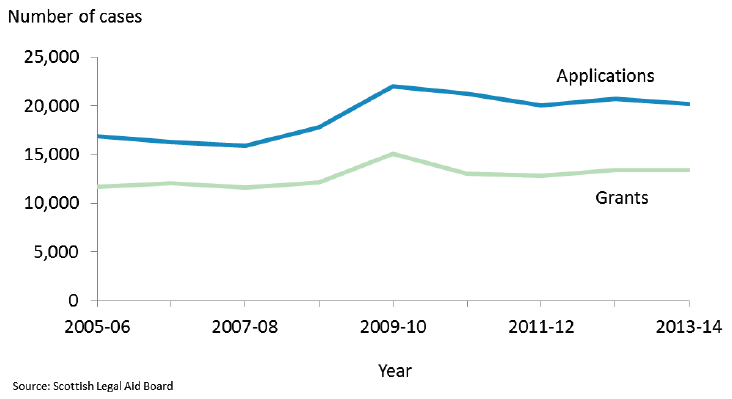
1. Applications and grants may not relate to the same cases because of the interval between an application and a decision to grant. Also note that granted cases may not always proceed.
Contact
Email: Alasdair Anthony
There is a problem
Thanks for your feedback